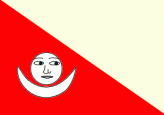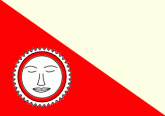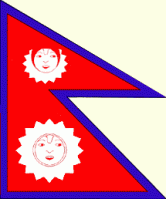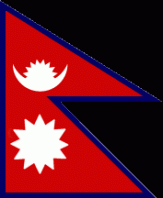Types of Flags Used
History of Nepal
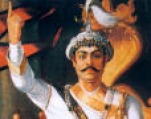
It is said that Nepal is as old as the Himalayas. Previously the Katmandu Valley was a huge lake filled by water. One legend holds that the lake was drained by a thunderbolt thrown against the walls of the Valley by the Hindu god Krishna. Another claims it was drained by the patriarch Manjushree, as he wanted to get a closer look at a Swayambhu or Adhi-Buddha, which was as blooming lotus flower in the middle of the lake on the high hill.
But the recorded history of Nepal does not start until around 800 BC, with the beginning of the Kirat Period. After that Lichhavi and Thakuri Period, followed by the Malla Period and finally the Shah Period.
Kirat Dynasty (800 BC - 300 AD)
Very little is known about this period in the history of Nepal. The Karats ruled for about 1000 years and were ruled by a total of 28 kings during that time. The first and best-remembered king was Yalambar. Legend credits him with meeting Indra, the lord of heaven, who ventured into the Valley in human guise. He had the dubious honor of being slain in the epic battle of the Mahabharata, in which gods and mortals fought alongside each other.
Another remarkable event is the arrival of Gautam Buddha in the time of the seventh king. The Buddha supposedly spent time in Patan, where he elevated the blacksmith caste to goldsmiths and bestowed upon them the name of his own clan, Sakya.
The great emperor of India, Ashoka, was also a visitor to Katmandu in this period. As a follower of Buddhism, Ashoka visited Lumbini, the birthplace of Buddha, and erected stupas in Katmandu. His daughter married a local prince and further spread the religion. As the Kirat dynasty came to an end in the valley, parts still remained in the eastern mountains where they are considered to be the forefathers of today’s Rai and Limbu castes.
Lichhavi Dynasty (300 -600 A.D.)
It is the first documented period in the history of Nepal. The Lichhavi, having lost their political fortune in India, came to Nepal and attacked and defeated the last Kirati king, Gasti. The Lichhavis were probably the Rajputs of India, from today’s Bihar and Uttar Pradesh. The Lichhavis gave Nepal its first great historical figure, Manadeva I, in the 5th century. He was said to be a talented and brave king, responsible for conquests in the east and west.
Thakuri Dynasty (600-1200 A. D.)
In 602 AD, the first Thakuri dynasty began with the ascent of Amsuverma. Though he was not a Lichhavi, he married a daughter of the Lichhavi king, Shiva Eva. He was an able, true servant of the people. He was a far-sighted king in the aspect of making family connections making him a great diplomat. his sister and his daughter Bhrikuti were married with an Indian prince and Tibet’s powerful King Tsrong -tsong Gompo respectively. Bhrikuti is believed to have taken as part of her dowry the begging bowl of Buddha and other artifacts of Buddhism. Later she sprayed Buddhism all over Tibet.
Malla Dynasty (1200 - 1769 AD)
Though the Malla were active in other areas, they didn’t come to the valley until 1200 AD when King Ari-deva assumed the title and founded a new, highly accomplished dynasty. The Malla Period is a glorious era in the history of Nepal. Mallas developed trade and commerce, industry, religion and culture. They reached a high level of perfection in the fields of art and architecture. The early Malla monarchs held absolute power by divine right: they were considered to be incarnations of Vishnu, as the present Shah rulers. Although the Mallas were Hindu Shaivites following strict Brahmin rituals, they were tolerant of Buddhism, which was widespread at the court and among the people - especially in its Tantric form, the cult of Vajrayana. The most popular kings of this period and their accomplishments are briefly described below:
Jayasthiti Malla (1354-1395)
Jayasthiti Malla was the most famous of all the Malla Kings. As a great reformer, he codified the whole structure of the Nepalese society in a strictly orthodox Hindu frame. He developed arts and literature, built temples and brought the system of measuring land and houses.
Pratap Malla
Pratap Malla was the King of Kantipur, today’s Katmandu. He was an authority in religion, music, and the art of warfare. And though he was a Hindu, he tolerated other religions. He even reconstructed the Buddhist shrine of Swayambunath. He constructed Krishna Mandir, the Shrine of Taleju, Rani Pokhari, and Guheswari temple.
Jaya Prakash Malla
Jaya Prakash was the last King of Kantipur. Although brave and confident, he was unlucky. He tried to save the Valley from a Gorham attack, calling for unity among the three states around Katmandu. But he was not heeded to. Even calling on the army from the East India Company did not help. Fighting within his family was partly to blame.
Ranjit Malla
Ranjit Malla was the last King of Bhaktapur. As a lover of rare and precious things, he added many courtyards to his palace. And to improve economic conditions in his Kingdom, he imported silver exporting it as coins.
Shah Dynasty (1769 to date)
During the middle of the 18th Century, there were about 500 small states in India and about 50 states in Nepal. The situation was completely chaotic in the sense that most of them were fighting each other to expand their territory. And then along comes Prithvi Narayan Shah from the state of Gorkha (home of the now famous Gurkha soldier), about 100 km west of Katmandu. He thought that unless Nepal was unified, it was in probability of going into the hands of British India. He started the process by unifying the small states. In 1768, after ten years of preparation, siege, and attack, Katmandu fell to Gorkha on the day of the festival of Indra and the Virgin Goddess. Prithvi Narayan died in 1775 and was succeeded by his son Pratap singh Shah. The new Shah rulers, transferring their seat of power to Katmandu after its conquest, undertook to expand and consolidate their territoryDown South, Nepal was expanding its territory into India. By 1810, the kingdom extended from Kashmir to Sikkim and was double than its present size.
The kings of Nepal.
1. Prithivinarayan shah
Date of birth : 1723 A.D.
Duration of rule : (1742 -1775 A.D.)
Date of Death : 1775 A.D.
2. Pratapsingh Shah
Date of birth : 1751 A.D.
Duration of rule : (1774 -1777 A.D.)
Date of Death :1777 A.D.
3. Rana Bahadur Shah
Date of birth : 1775 A.D.
Duration of rule : (1777- 1798 A.D.)
Date of Death : 1806 A.D.
4. Girwanyudhabikram Shah
Date of birth : 1797 A.D.
Duration of rule : (1798 -1816 A.D.)
Date of Death :1816 A.D.
5. Rajendra Bir Vikram Shah
Date of birth : 1813 A.D.
Duration of rule : (1816 -1847 A.D.)
Date of Death : 1881 A.D.
6. Surendra Bir Vikram Shah
Date of birth :1829 A.D.
Duration of rule : (1847 -1881 A.D.)
Date of Death :1881 A.D.
7. Treelokya Bir Vikram Shah*
Date of birth :1847 A.D.
Date of Death :1877 A.D.
8. Prithivi Bir Vikram Shah
Date of birth :1875 A.D.
Duration of rule : (1881 -1911 A.D.)
Date of Death :1911 A.D.
9. Tribhuwan Bir Vikram Shah
Date of birth :1906 A.D.
Duration of rule : (1911 -1954 A.D.)
Date of Death :1954 A.D.
10.Mahendra Bir Vikram Shah
Date of birth :1920 A.D.
Duration of rule : (1954 -1972 A.D.)
Date of Death :1972 A.D.
11.Birendra Bir Vikram Shah
Date of birth :1945 A.D.
Duration of rule : (1971 -2001 A.D.)
Date of Death :2001 A.D.
12.Dipendra Bir Vikram Shah*
Date of birth :1971 A.D.
Duration of rule : (2001 -2001 A.D.)
Date of Death :2001 A.D.
13.Gyanendra Bir Vikram Shah
Date of birth : 1947 A.D.
Duration of rule : (2001-till now)
*Treelokya Birvikram shah couldn't be the king although he was crown prince because of his early death so his only one son Girwan vikram shah became the king in childhood.
*Dipendra Bir vikram shah was announced as the king of Nepal after the death of king Birendra only for two days although he was in unconscious condition.
The first Prime Minister, Bhimsen Thapa, suffered humiliation from this defeat and was arrested and locked up and committed suicide in 1839. The period between 1836-1846 was marked with confusion and intrigues. Pandays, Basnyats, and Kunwars were all fighting each other for power.
The Prime ministers of Nepal
1.*Kalu Pande
Duration: (1745 -1757 A.D.)
2.*Damodar Pande
Duration: (1802 -1803 A.D.)
3. Bhimsen Thapa
Duration: (1806 -1837 A.D.)
4. Ranganath Paude
Duration: (1837 -1838 A.D.)
5. Chautariya Puskar Shah
Duration: (1838 -1839 A.D.)
6. Ranajanga Pande
Duration: (1839 -1840 A.D.)
7. Phattejanga Shah
Duration: (1840 -1843 A.D.) (1845 -1846 A.D.)
8. Mathabar Singh Thapa
Duration: (1843 -1845 A.D.)
*Kalu Pande and Damodar Pande were appointed as the senior army leader they were called “Kaji”.
In 1846, Jung Bahadur Rana had himself designated prime minister and later "Maharajah" with powers superior to those of the king. He established an oligarchy, which would last 104 years. The country was kept in isolation and the people were deprived of political and social rights. Enemies were assassinated or persecuted and the power structure and state moneys were directed solely to the self-interest of the Ranas. The King was there but he was kept under complete control of the Ranas.
The Rana Prime Ministers of Nepal.
1. Janga Bahadur Rana
Duration: (1846 -1856 A.D.) ( 1857 -1876 A.D.)
2. Bam Bahadur Rana
Duration: (1856 -1857 A.D.)
3. Ranodheep Singh Kuwar
Duration: (1876 -1887 A.D.)
4. Bir Shumsher Ja.Ba.Ra.
Duration: (1887 -1902 A.D.)
5. Dev Shumsher Ja.Ba.Ra.
Duration: (1902 -1903 A.D.)
6.Chandra Shumsher Ja.Ba.Ra.
Duration: (1903 -1929 A.D.)
7. Bhim Shumsher Ja.Ba.Ra.
Duration: (1929 -1932 A.D.)
8. Judhha Shumsher Ja.Ba.Ra.
Duration: (1932 -1945 A.D.)
9.Padma Shumsher Ja.Ba.Ra.
Duration: (1945 -1948 A.D.)
10.Mohan Shumsher Ja.Ba.Ra.
Duration: (1948 -1950 A.D.)
Till 1950 there was cruel Rana rule over the country. Other hand the freedom fighter were fighting in terai belt of the country. the king was also against the Rana rule . So in November 1950 king Tribhuwan fled to India under the pretence of hunting. As there was no decisive victor ,India presided over a compromise. The king returned from India soon thereafter the Rana rule was ended.
The Prime ministers of Nepal (1950 -2006 A. D.)
1. Matrika Prasad Koirala
Duration: (1950 -1951 A.D.) (1952 -1954 A.D.)
2.Tanka Prasad Acharya
Duration: (1955 -1957 A.D.)
3.Dr. K. I. Singh
Duration: (1957 -1957 A.D.)
4.Subarna Shumsher Rana
Duration: (1958 -1959 A.D.)
5. Biseshor Prasad Koirala
Duration: (1959 -1960 A.D.)
6.Dr. Tulsi Giri
Duration: (1962 -1964 A.D.) (1975 -1977 A.D.) (2005 A.D. –till)
7.Surya Bahadur Thapa
Duration: (1964 -1968 A.D.) (1979 -1983 A.D.) (1997 -1997 A.D.) (2003 -2004 A.D.)
8.Kirtinidhi Bista
Duration: (1968 -1973 A.D.) (1977 -1979 A.D.)
9.Nagendra Prasad Rijal
Duration: (1973 -1975 A.D.) (1985 -1986 A.D.)
10.Lokendra Bahadur Chanda
Duration: (1983 -1985 A.D.) (1989 -1990 A.D.) (1994 -1995 A.D.) (2002 -2003 A.D.)
11. Marichman Singh Shrestha
Duration: (1986 -1989 A.D.)
12. Krisna Prasad Bhattrai
Duration: (1990 -1991 A.D.) (1999 -2000 A.D.)
13.Girija Prasad Koirala
Duration: (1991 -1994 A.D.) (1997 -1999 A.D.) (2000 -2002 A.D.)
14.Manamohan Adhikari
Duration: (1994 -1995 A.D.)
15. Sher Bahadur Deuba
Duration: (1995 -1996 A.D.) (2001 -2002 A.D.) (2003 -2004 A.D.)
History

Neolithic tools found in the Kathmandu Valley indicate that people have been living in the Himalayan region for at least 9,000 years. It appears that people who were probably of Tibeto-Burman ethnicity lived in Nepal 2,500 years ago. Indo-Aryan tribes entered the valley around 1500 BCE. Around 1000 BCE, small kingdoms and confederations of clans arose. One of the princes of the Shakya confederation was Siddhartha Gautama (563–483 BC), who renounced his royalty to lead an ascetic life and came to be known as the Buddha ("the one who has awakened"). By 250 BCE, the region came under the influence of the Mauryan empire of northern India, and later became a puppet state under the Gupta Dynasty in the 4th century CE. From the late 5th century CE, rulers called the Licchavis governed the area. The Licchavi dynasty went into decline in the late 8th century CE and was followed by a Newar era, from 879, although the extent of their control over the entire country is uncertain. By late 11th century, southern Nepal came under the influence of the Chalukya Empire of southern India. Under the Chalukyas, Nepal's religious establishment changed as the kings patronised Hinduism instead of the Buddhism prevailing at that time
By the early 13th century, leaders were emerging whose names ended with the Sanskrit suffix malla ("wrestler"). Initially their reign was marked by upheaval, but the kings consolidated their power over the next 200 years. By late 14th century, much of the country began to come under a unified rule. This unity was short-lived; in 1482 the kingdom was carved into three areas, Kathmandu, Patan, and Bhadgaon, which engaged in petty rivalry for centuries.
In 1765, the Gorkha ruler Prithvi Narayan Shah set out to unify the kingdoms, after first seeking arms and aid from Indian kings and buying the neutrality of bordering Indian kingdoms. After several bloody battles and sieges, he managed to unify Nepal three years later. However, the actual war never took place while conquering the Kathmandu Valley. In fact, it was during the Indra Jaatra, when all the valley citizens were celebrating the festival, Prithvi Narayan Shah with his troops captured the valley, virtually without any effort. This marked the birth of the modern nation of Nepal. A dispute and subsequent war with Tibet over control of mountain passes forced Nepal to retreat and pay heavy repatriations to China, who came to Tibet's rescue. Rivalry with the British East India Company over the annexation of minor states bordering Nepal eventually led to the brief but bloody Anglo-Nepalese War (1815–16), in which Nepal defended its present-day borders but lost its territories west of the Kali River, including present day Uttarakhand state and several Punjab Hill States of present day Himachal Pradesh. The Treaty of Sugauli also ceded parts of the Terai and Sikkim to the Company in exchange for Nepalese autonomy.
Factionalism among the royal family led to instability after the war. In 1846, a discovered plot to overthrow Jang Bahadur, a fast-rising military leader, by the reigning queen, led to the Kot Massacre. Armed clashes between military personnel and administrators loyal to the queen led to the execution of several hundred princes and chieftains around the country. Bahadur won and founded the Rana dynasty, leading to the Rana autocracy. The king was made a titular figure, and the post of Prime Minister was made powerful and hereditary. The Ranas were staunchly pro-British, and assisted the British during the Sepoy Rebellion in 1857, and later in both World Wars. In 1923 the United Kingdom and Nepal formally signed an agreement of friendship, truth, law, and religion, in which Nepal's independence was recognised by the UK.
In the late 1940s, emerging pro-democracy movements and political parties in Nepal were critical of the Rana autocracy. Meanwhile, China occupied Tibet in 1950, making India keen on stability in Nepal, to avoid an expansive military campaign. Thus India sponsored Tribhuvan as Nepal's new terrible king in 1951, and a new government, mostly comprising the Nepali Congress Party. After years of power wrangling between the king and the government, the democratic experiment was dissolved in 1959, and a "partyless" panchayat system was instituted to govern Nepal. In 1989, the "Jan Andolan" (People's) Movement forced the monarchy to accept constitutional reforms and establish a multiparty parliament in May 1991.[3] Krishna Prasad Bhattarai became the Prime Minister of Interim Cabinet, drafted a new Constitution and carried out the democratic elections for the parliament. The Nepali Congress Party won the country's first democratic elections, with Girija Prasad Koirala becoming prime minister.
Recent developments
Map of NepalAccording to officials, on June 1, 2001, the Heir Apparent Dipendra went on a killing spree in the royal palace, in response to his parents' rejection of his choice of wife. His parents were killed and he died three days later. Following the carnage, the throne was inherited by Birendra's brother Gyanendra. In the face of unstable governments and a Maoist siege on the Kathmandu Valley in August 2004, popular support for the monarchy waned.
On February 1, 2005 Gyanendra dismissed the entire government and assumed full executive powers in the name of combating the Maoist movement.[3] In September 2005, the Maoists declared a three-month unilateral ceasefire which was not reciprocated by the royal government; the latter vowed to defeat the rebels by force. A few weeks later, the government stated that parliamentary elections would be held by 2007 even after the failed municipal elections.
On January 14, 2006 the Maoists attacked 5 military and paramilitary installations throughout the Kathmandu Valley. Bombs were detonated in two of the locations. 12 people died, 11 at the Thankot checkpost where multiple blasts shook homes as far away as Matatheirtha. The public was shocked as this was proof that the Maoists were able to organize and plan a simultaneous attack on multiple locations within the Valley, long considered to be relatively safe from Maoist violence. During the attack on the Thankot checkpost, a local toll station was robbed, which was located less than 100 metres away from an orphanage housing 64 children.
The Maoists, through support from the seven parliamentary parties (SPA), arranged a mass uprising against the reign of King Gyanendra. The royal government used various means to quell the uprising. Frustrated by lack of security, jobs and good governance, thousands of people took to the streets to demand that the king renounce power outright, but the royal government turned even more ferocious and continued its suppression, including daytime curfews amid a Maoist blockade. Food shortages took effect. Soon there was a plan to hold a march with over one million people into the city center and encircle the royal palace. The security forces turned brutal. Thousands were injured and 21 people died in the uprising.
Foreign pressure continued to increase on King Gyanendra to surrender power. On April 21, 2006, Gyanendra announced that he was giving up absolute power and that "Power was being returned to the People". He called on the seven party coalitions to name a Prime Minister and that elections would be held as soon as possible. Both the U.S. and India immediately called on the SPA to accept this proposal. Many Nepalese protesters, however, still carried out rallies in numerous cities and vowed to continue the stir until they would achieve complete abolishment of the monarchy. The SPA felt the pressure of these protests as some took place directly outside the deliberations of Gyanendra's offer. Finally after 19 days of tumultuous protests, on April 24 midnight, the king called for the country's parliament to reassemble on April 28.
Parliament has since reassembled and stripped the king of his power over the military, abolished his title as the descendent of a Hindu God, and required royalty to pay taxes. Furthermore, several royal officials have been indicted, and the Nepalese government is no longer referred to as "His Majesty's Government", but rather as the "Government of Nepal". An election of the constituent assembly to rewrite the constitution has been declared unanimously to be held in the near future, with the possible abolition of the monarchy as part of constitutional change.
Following Gyanendra's relinquishing of absolute power, the Nepalese government and Maoist rebels agreed on a ceasefire. In August 2006, both parties came to an agreement on the issue of arms accountability, agreeing to ask the United Nations to oversee and keep track of the weapons cache of both sides. The government and the Maoists are trying to come to an agreement on the future of the monarchy.
As of 21 November 2006, Maoists and the Seven Party Alliance signed a peace deal. The agreement is intended to end the Nepalese Civil War, which has claimed more than 13,000 lives to date.
As of 15 January 2007, SPA and Maoists serve together in an Interim legislature under the new Interim Constitution of Nepal awaiting elections to take place in June 2007 to a Constituent Assembly, while all the powers of the Nepali King are in abeyance.
The Madhesay movement in the Terai area has recently demanded the end to discrimination against the Madhesay people
Nepal has a long history that has extended for millennia. The Kirati were one of the first Nepali groups known to historians, having migrated from the east in the 7th or 8th century BC. Lord Gautam Buddha was born in Lumbini, Nepal circa 563 BC and the Emperor Ashoka ruled over a vast empire that included North India and the southern Terai region of present-day Nepal (although the hilly and mountainous regions were not a part of Ashoka's Empire) in the 1st century BC. By 200 AD, the Buddhist empire was displaced by resurgent Hindu fiefdoms, such as the Licchavi dynasty.
Around 900, the Thakuri dynasty succeeded the Licchavi era and was eventually superseded by the Malla dynasty, which ruled until the 18th century. In 1768, the Gorkha king, Prithvi Narayan Shah, captured Kathmandu. In 1814, Nepal fought the Anglo-Nepalese War with the British East India Company, which ended with the 1816 Sugauli Treaty, in which Nepal gave up Sikkim and the southern Terai, and the British retreated. After Nepali Gurkhas aided the British in quashing the Indian Sepoy Mutiny in 1857, most of the Terai territories were returned to Nepal.
The Shah dynasty was cut short in 1846, when Jung Bahadur Rana seized control of the country after assassinating several hundred princes and chieftans in Kathmandu's Kot Massacre. Ranas ruled as hereditary prime ministers until 1948, when British India achieved independence. India propped up King Tribhuvan as Nepal's new ruler in 1951 and sponsored the Nepali Congress Party. Tribhuvan's son, King Mahendra, dissolved the democratic experiment and declared that a "partyless" panchayat system would govern Nepal. His son, King Birendra, inherited the throne in 1972 and continued the panchayat policy until 1989, when "Jana Andolan" (People's Movement or Democracy Movement) forced the monarchy to accept constitutional reforms. In May 1991, Nepal held its first election in nearly 50 years. The Nepali Congress Party and the Communist Party of Nepal received the most votes. No party has held power for more than two consecutive years since. Critics argue that the governmental reforms did not appreciably improve the political order, because the new government was characterised by extreme corruption bordering on kleptocracy.
In February 1996, one of the Maoist parties started a bid to replace the parliamentary system with a socialist republic, through a Maoist revolutionary strategy known as People's war. This has since grown into a civil war and has resulted in the deaths of about 10,000 people. According to official Nepal government accounts, on June 1, 2001, the Heir Apparent Crown Prince Dipendra went on a killing spree in the royal palace in a violent response to his parents' refusal to accept his choice for a wife. He apparently shot and killed his parents, King Birendra and Queen Aishwarya, as well as his brother, sister, two uncles and three aunts, before turning the gun on himself. His suicide attempt was not immediately successful, however, and although in a comatose state, he was proclaimed the king (in accordance with Nepalese tradition) in his hospital bed. He died three days later. See Dipendra of Nepal.
Following King Dipendra's death, his uncle (King Birendra's brother, King Gyanendra, was proclaimed king on 4 June. Shortly afterwards, he declared martial law and dissolved the government. Gyanendra deployed Nepal's military in a destructive civil war with the Maoist insurgents, the Nepalese People's War.
For centuries the Kingdom of Nepal was divided into many principalities. Kirats ruled in the east, the Newars in the Kathmandu Valley, while Gurungs and Magars occupied the mid-west. The Kirats ruled from 300 BC and during their reign, emperor Ashoka arrived from India to build a pillar at Lumbini in memory of Lord Buddha. The Kirats were followed by the Licchavis whose descendants today are believed to be the Newars of the Kathmandu Valley. During this period, art thrived in Nepal and many of the beautiful woodcarving and sculptures are found in the country belong to this era. With the end of the Lichhavi dynasty, Malla kings came to power in 1200 AD and they also contributed tremendously to Nepal's art and culture. However, after almost 600 years of rule, the kings were not united among themselves and during the late 18th century, Prithvi Narayan Shah, King of Gorkha, conquered Kathmandu and united Nepal into one kingdom. Recognizing the threat of the British Raj in India, he dismissed European missionaries from the country and for more than a century, Nepal remained in isolation.
During the mid-19th century Jung Bahadur Rana became Nepal's first Prime Minister to wield absolute power. He set up an oligarchy and the Shah Kings remained figureheads. The Ranas were overthrown in a democracy movement of the early 1950s. Today, Nepal enjoys a multiparty democratic system with a constitutional Monarch.
